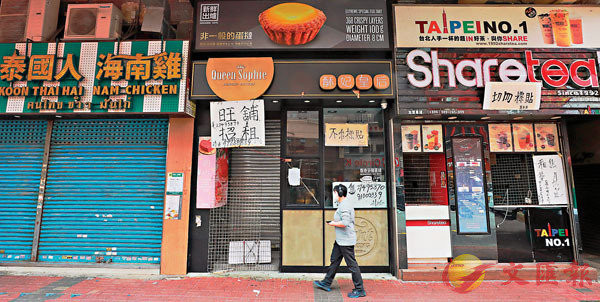It is estimated to rise above 930 units in the third quarter because of the hits of violent demonstrations and the epidemic.
The Hong Kong economy has been hit by violent demonstrations that lasted more than half a year and the recent COVID-19 epidemic, and the retail industry is entering a significant recession. The latest survey shows that from January to February this year, the number of vacant shops in the four core business districts of Hong Kong (Tsim Sha Tsui, Mong Kok, Causeway Bay, Central) increased to 689, an increase of 207 from the third quarter of last year. And the vacancy rate is 9.2%, a new record high. Thereinto, the vacancy rate in Causeway Bay District reaches 12.2%, maintaining the highest among the fourth districts. The survey predicts that the full impact of the epidemic will be reflected in the third quarter, when the vacancy rate in the core areas may rise to 12.5%, and the number of vacant shops will increase to more than 930. The shop market has entered a "super-large adjustment period," and the rent and sale prices of shops in core areas would fall by 30% to 40% before the end of the year, returning to level in 2006-2007.
(by Lai ChiTin)
Midland Non-residential Properties yesterday released a survey of vacant shops in the first quarter of this year. The study sampled the four core business districts of Hong Kong, namely Tsim Sha Tsui, Mong Kok, Causeway Bay, and Central. It has156 streets involving 7,503 shops. Since the survey was conducted around the Lunar New Year, the data mainly reflects the impact on the shop market over a half year after the social movements and the beginning of the COVID-19 epidemic. The survey indicates that the data in the third quarter will fully reflect the changes in the market after the outbreak of the epidemic.
Vacant shops in the four core areas are 689 units.
Chen Ho-Cheung, an analyst of Data Research division Department of Midland Non-residential Properties, pointed out yesterday that visitors to Hong Kong have significantly decreased, and residents' willingness to consume has declined, due to the impact of amendment crisis. He said many merchants have closed, and the overall vacant shop number and the vacancy rate sharply rise. The survey in the first quarter of this year showed that in the four core areas, there were 689 vacant shops, a 207 increase over the third quarter of last year. And the vacancy rate was as high as 9.2%, sharply rising by 2.7% from 6.5% in the third quarter of last year. Both vacant shop numbers and the vacancy rate are the new record high in five years.
The vacancy rates of the four core areas have risen across the board. The situation in traditional tourist areas is more serious. The vacancy rate in Causeway Bay is as high as 12.2%, which is the highest among the four regions. This vacancy rate is the highest on record. Chen Ho-Cheung said that the impact on Causeway Bay is the most direct, because "social movements" often occur in this area. However, Mong Kok district, which has more local consumption elements, performed slightly better, with the vacancy rate rising by only 2.1% to 6.4% in half a year.
Most of the closedowns happen in the food and beverage industry.
The survey shows that the performance of the visitor street and the local consumer street was polarized. Lan Kwai Fong area in Central recorded 12 vacant shops, the highest on record. Tsim Sha Tsui and Granville Road, which relied on tourists' consumption in the past, registered 29 vacant shops, ranking the top in four districts. On the contrary, the street shops that focus on local consumer businesses have a stronger capability against market falling. So the number of vacant shops in these streets remained stable and even recorded a decrease. For example, Flower Market Road and Tung Choi Street (section of Goldfish Street), which are Mong Kok's characteristic streets, both recorded a decrease in the latest vacancy rates.
The amendment crisis badly hit the business of the catering industry in the traditional busy area. Chen Ho-Cheung expressed that the number of catering merchants had dropped from 1,886 to 1,824 in the third quarter of last year, which was the highest among various industries, and Chinese restaurants among decreased from 641 to 611. Tourist-related industries are also the hardest-hit areas. Merchants of jewelry and watch shops, pharmacies, cosmetics shops, and clothing/shoes/leather goods all recorded double-digit declines. Among them, clothing/shoes/leather goods merchants saw a net decrease of 49 in half a year, with the latest number of only 842.
Beauty shops and barbershops move to the street.
The industries aim to local consumption rise against the leading market. For example, the number of beauty shops and barbershops increases across the board in four districts, with a net increase of 19 within half a year, the most among various industries. This increase mainly due to the sharp drop in the rents of street shops, which has enabled tenants previously operating only in shopping malls or upstairs shops to sublet street shops. Also, the number of stores in some industries related to daily necessities and household goods, as well as businesses related to personal interests, performed steadily.
